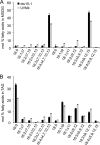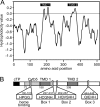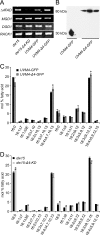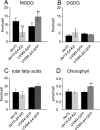A cytochrome b5-containing plastid-located fatty acid desaturase from Chlamydomonas reinhardtii
- PMID: 22562471
- PMCID: PMC3416504
- DOI: 10.1128/EC.00079-12
A cytochrome b5-containing plastid-located fatty acid desaturase from Chlamydomonas reinhardtii
Abstract
Monogalactosyldiacylglycerol (MGDG) in Chlamydomonas reinhardtii and other green algae contains hexadeca-4,7,10,13-tetraenoic acid (16:4) in the glycerol sn-2 position. While many genes necessary for the introduction of acyl chain double bonds have been functionally characterized, the Δ4-desaturase remained unknown. Using a phylogenetic comparison, a candidate gene encoding the MGDG-specific Δ4-desaturase from Chlamydomonas (CrΔ4FAD) was identified. CrΔ4FAD shows all characteristic features of a membrane-bound desaturase, including three histidine boxes and a transit peptide for chloroplast targeting. But it also has an N-terminal cytochrome b(5) domain, distinguishing it from other known plastid desaturases. Cytochrome b(5) is the primary electron donor for endoplasmic reticulum (ER) desaturases and is often fused to the desaturase domain in desaturases modifying the carboxyl end of the acyl group. Difference absorbance spectra of the recombinant cytochrome b(5) domain of CrΔ4FAD showed that it is functional in vitro. Green fluorescent protein fusions of CrΔ4FAD localized to the plastid envelope in Chlamydomonas. Interestingly, overproduction of CrΔ4FAD in Chlamydomonas not only increased levels of 16:4 acyl groups in cell extracts but specifically increased the total amount of MGDG. Vice versa, the amount of MGDG was lowered in lines with reduced levels of CrΔ4FAD. These data suggest a link between MGDG molecular species composition and galactolipid abundance in the alga, as well as a specific function for this fatty acid in MGDG.
Figures






Similar articles
-
Critical role of Chlamydomonas reinhardtii ferredoxin-5 in maintaining membrane structure and dark metabolism.Proc Natl Acad Sci U S A. 2015 Dec 1;112(48):14978-83. doi: 10.1073/pnas.1515240112. Epub 2015 Nov 16. Proc Natl Acad Sci U S A. 2015. PMID: 26627249 Free PMC article.
-
The green microalga Chlamydomonas reinhardtii has a single ω-3 fatty acid desaturase that localizes to the chloroplast and impacts both plastidic and extraplastidic membrane lipids.Plant Physiol. 2013 Oct;163(2):914-28. doi: 10.1104/pp.113.223941. Epub 2013 Aug 19. Plant Physiol. 2013. PMID: 23958863 Free PMC article.
-
A mutant of the Arabidopsis thaliana TOC159 gene accumulates reduced levels of linolenic acid and monogalactosyldiacylglycerol.Plant Physiol Biochem. 2013 Dec;73:344-50. doi: 10.1016/j.plaphy.2013.10.018. Epub 2013 Oct 21. Plant Physiol Biochem. 2013. PMID: 24184455
-
The role of cytochrome b5 fusion desaturases in the synthesis of polyunsaturated fatty acids.Prostaglandins Leukot Essent Fatty Acids. 2003 Feb;68(2):135-43. doi: 10.1016/s0952-3278(02)00263-6. Prostaglandins Leukot Essent Fatty Acids. 2003. PMID: 12538077 Review.
-
Metabolism of acyl-lipids in Chlamydomonas reinhardtii.Plant J. 2015 May;82(3):504-522. doi: 10.1111/tpj.12787. Epub 2015 Mar 3. Plant J. 2015. PMID: 25660108 Review.
Cited by
-
Endoplasmic reticulum retention signaling and transmembrane channel proteins predicted for oilseed ω3 fatty acid desaturase 3 (FAD3) genes.Funct Integr Genomics. 2020 May;20(3):433-458. doi: 10.1007/s10142-019-00718-8. Epub 2019 Nov 28. Funct Integr Genomics. 2020. PMID: 31781992
-
Large fluxes of fatty acids from membranes to triacylglycerol and back during N-deprivation and recovery in Chlamydomonas.Plant Physiol. 2021 Apr 2;185(3):796-814. doi: 10.1093/plphys/kiaa071. Plant Physiol. 2021. PMID: 33822218 Free PMC article.
-
Critical role of Chlamydomonas reinhardtii ferredoxin-5 in maintaining membrane structure and dark metabolism.Proc Natl Acad Sci U S A. 2015 Dec 1;112(48):14978-83. doi: 10.1073/pnas.1515240112. Epub 2015 Nov 16. Proc Natl Acad Sci U S A. 2015. PMID: 26627249 Free PMC article.
-
Chlamydomonas CHT7 Is Required for an Effective Quiescent State by Regulating Nutrient-Responsive Cell Cycle Gene Expression.Plant Cell. 2020 Apr;32(4):1240-1269. doi: 10.1105/tpc.19.00628. Epub 2020 Jan 30. Plant Cell. 2020. PMID: 32001503 Free PMC article.
-
Classification and substrate head-group specificity of membrane fatty acid desaturases.Comput Struct Biotechnol J. 2016 Sep 12;14:341-349. doi: 10.1016/j.csbj.2016.08.003. eCollection 2016. Comput Struct Biotechnol J. 2016. PMID: 27708750 Free PMC article.
References
-
- Abramoff M, Magelhaes P, Ram S. 2004. Image processing with ImageJ. Biophotonics Int. 11:36–42
-
- Altschul SF, Gish W, Miller W, Myers EW, Lipman DJ. 1990. Basic local alignment search tool. J. Mol. Biol. 215:403–410 - PubMed
-
- Bligh EG, Dyer WJ. 1959. A rapid method of total lipid extraction and purification. Can. J. Biochem. Physiol. 37:911–917 - PubMed
Publication types
MeSH terms
Substances
Associated data
- Actions
LinkOut - more resources
Full Text Sources
Molecular Biology Databases

